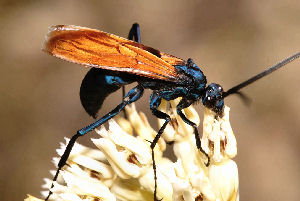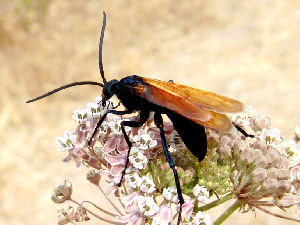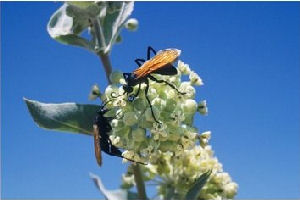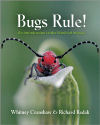
HOME
INTRO
SYMBOLS
ALMANAC
ECONOMY
GEOGRAPHY
STATE MAPS
PEOPLE
GOVERNMENT
FORUM
NEWS
COOL SCHOOLS
STATE QUIZ
STATE LINKS
BOOK STORE
MARKETPLACE
NETSTATE.STORE
NETSTATE.MALL
GUESTBOOK
CONTACT US


Tweet
Double click on word for definition.
New Mexico State Insect
As the year 1988 drew to a close, fewer than half of the states had adopted official state insects.
Ruth Bradford, who taught fourth, fifth and sixth grades at Edgewood Elementary School in Edgewood, New Mexico, had been inspiring her sixth-grade students with a hands-on approach to learning. She had prompted her charges with an idea to actually become involved with the legislative process by way of designating an official state insect for New Mexico. She wanted her students to see that
"kids could see they make a difference and to have a goal, something to work on." [ 1 ]
(Wittenauer Front Page)
In 1987, her class surveyed the states and found that only 16 had designated an official state insect and New Mexico wasn't on the list. In fact, at the time, the number of states with official insects was 21 and Tennessee had adopted two! Twelve states had adopted the honeybee!
In 1988, her class contacted entomologists and scientists across the state seeking their recomendations for an official state insect. They recieved responses from almost 20 scientists nominating a number of insects they thought deserving of the honor; the assassin bug; the black cactus longhorn beetle; the Jerusalem cricket; the pictured grasshopper; the sphinx or hawk moth; the tarantula hawk wasp; and the yucca moth.
With two years of preparatory work behind them, the students began efforts intended to result in legislation, to be introduced in 1989, designating an official state insect for New Mexico.
First, the list of nominees was culled by a survey of 532 students within the Moriarty School District. The Jerusalem cricket, the tarantula hawk wasp, and the yucca moth were selected as the three contenders for a statewide ballot.
Next, ballots were sent to 406 New Mexico schools to determine a preference for a particular insect that the Edgewood students planned to put before the New Mexico Legislature in 1989. The winner of the ballot initiative was scheduled to be announced on March 30, 1988.

New Mexico State Insect: Tarantula Hawk Wasp
Photograph: National Park Service
The winner? Completed ballots were returned by almost 10,000 fourth, fifth, and sixth graders from 100 New Mexico Schools. The tarantula hawk wasp was the overwhelming favorite of kids across the state, receiving over 50% of the vote, nearly 6,000 votes. The yucca moth took second place.
Why the tarantula hawk wasp? Perhaps one of the main reasons was the interesting way in which the female wasp goes about raising her young.
The female slowly approaches and then stings the much larger tarantula, which offers no resistance and acts as if it is hypnotized. The paralyzed spider is then dragged to a previously prepared burrow, where it is implanted with an egg and serves as food for the developing larva. [ 2 ]
("New Mexico Legislative Council Handbook")
As Ruth Bradford mentioned to the New Mexican, "The kids love blood and guts." [ 1 ]
Now that a candidate insect to represent New Mexico had been chosen by students, legislation would have to be written to make it official. Ruth Bradford and her students approached State Representative Gary King to craft and introduce the legislation that was intended make their unofficial insect an official insect. Rep. King agreed to help with the project and House Bill No. 468 was introduced to the New Mexico State Legislature.
The bill was referred to the House Consumer and Public Affairs Committee.
At this point, Ruth Bradford had left Edgewood and was teaching in Aniak, Alaska. A long way from New Mexico, she made time to attend the committee hearing with some of her Alaskan students.
The bill was unanimously approved by the committee, on February 16, 1989, and the doors were opened to a full vote of the House. Meanwhile, a Senate backup or companion bill, Senate Bill No. 287, was introduced by Senator Ray Tice.
Resistance to the legislation in the full House was minor with Representative Rubin Smith suggesting that the cockroach, "La Cucaracha," be substituted for the tarantula hawk wasp. He quickly withdrew his amendment, however, after a somewhat silly, one verse rendition of "La Cucaracha" with Representative Barbara Casey. Put to a vote in the full State House of Representatives, House Bill No. 468 found itself well approved by a vote of 62-4. It was quickly sent to the State Senate for consideration.
Within two weeks, the Senate approved the bill unanimously.
It took a bit of time but eventually the Edgewood Elementary School students prevailed.
On Monday, April 03, 1989, Governor Garrey Carruthers signed House Bill No. 468 declaring the tarantula hawk wasp (Pepsis formosa) the official insect of the State of New Mexico.
New Mexico Law

New Mexico State Insect: Tarantula Hawk Wasp (Male)
The following information was excerpted from the New Mexico Statutes, Chapter 12, Article 3, Section 12-3-4.
CHAPTER 12. Miscellaneous Public Affairs Matters.
ARTICLE 3. State Seal, Song and Symbols, 12-3-1 through 12-3-17.
12-3-4. State flower; state bird; state tree; state fish; state animal; state vegetables; state gem; state grass; state fossil; state cookie; state insect; state question; state answer; state nickname; state butterfly; state reptile; state amphibian; state aircraft; state historic railroad; state tie; state necklace.
A. The yucca flower is adopted as the official flower of New Mexico.
B. The chaparral bird, commonly called roadrunner, is adopted as the official bird of New Mexico.
C. The nut pine or pinon tree, scientifically known as Pinus edulis, is adopted as the official tree of New Mexico.
D. The native New Mexico cutthroat trout is adopted as the official fish of New Mexico.
E. The native New Mexico black bear is adopted as the official animal of New Mexico.
F. The chile, the Spanish adaptation of the chilli, and the pinto bean, commonly known as the frijol, are adopted as the official vegetables of New Mexico.
G. The turquoise is adopted as the official gem of New Mexico.
H. The blue grama grass, scientifically known as Bouteloua gracillis, is adopted as the official grass of New Mexico.
I. The Coelophysis is adopted as the official fossil of New Mexico.
J. The bizcochito is adopted as the official cookie of New Mexico.
K. The tarantula hawk wasp, scientifically known as Pepsis formosa, is adopted as the official insect of New Mexico.
L. "Red or green?" is adopted as the official question of New Mexico.
M. "Red and green or Christmas" is adopted as the official answer of New Mexico.
N. "The Land of Enchantment" is adopted as the official nickname of New Mexico.
O. The Sandia hairstreak is adopted as the official butterfly of New Mexico.
P. The New Mexico whiptail lizard, scientifically known as Cnemidophorus neomexicanus, is adopted as the official reptile of New Mexico.
Q. The New Mexico spadefoot toad, scientifically known as Spea multiplicata, is adopted as the official amphibian of New Mexico.
R. The hot air balloon is adopted as the official aircraft of New Mexico.
S. The Cumbres and Toltec scenic railroad is adopted as the official historic railroad of New Mexico.
T. The bolo tie is adopted as the official tie of New Mexico.
U. The Native American squash blossom necklace is adopted as the official necklace of New Mexico.
History: Laws 1927, ch. 102, § 1; C.S. 1929, § 129-101; 1941 Comp., § 3-1303; Laws 1949, ch. 142, § 1; 1953 Comp., § 4-14-3; Laws 1955, ch. 245, § 1; 1963, ch. 2, § 1; 1965, ch. 20, § 1; 1967, ch. 51, § 1; 1967, ch. 118, § 1; 1973, ch. 95, § 1; 1981, ch. 123, § 1; 1989, ch. 8, § 1; 1989, ch. 154, § 1; 1999, ch. 266, § 1; 1999, ch. 271, § 1; 2003, ch. 182, § 1; 2005, ch. 4, § 1; 2005, ch. 254, § 1; 2007, ch. 10, § 1; 2007, ch. 179, § 1; 2011, ch. 52, § 1.
Sources...
[ 1 ] Wittenauer, Cheryl. "Edgewood students have a bug about this project." New Mexican [Santa Fe] 09 March 1988, Front Page. Print.
[ 2 ] "New Mexico Legislative Council Handbook." New Mexico State Legislature. The State of New Mexico, n.d. Web. 6 Nov 2013.
The Associated Press. "Wasp wings to victory." New Mexican [Santa Fe] 03 March 1989, A-5. Print.
"Bill names cookie, wasp." Roswell Daily Record [Roswell] 17 February 1989, 7. Print.
The Associated Press. "Students select unofficial NM insect." New Mexican [Santa Fe] 21 March 1988, A-3. Print.
"NMSA (Unannotated)." New Mexico Public Access Law – Statutes and Court Rules (Unannotated) . New Mexico Compilation Commission. Web. 5 Nov 2013.
Shearer, Benjamin F. and Barbara S. State Names, Seals, Flags and Symbols: A Historical Guide Third Edition, Revised and Expanded. Westport, Conn: Greenwood Press, 3 Sub edition, 2001.
Additional Information

Tarantula Hawk Wasp Photographic Print
State Insect: Office of the New Mexico Secretary of State.
Animal Fact Sheet: Pepsis Wasp: from the Arizona-Sonora Desert Museum.
New Mexico State Insect: by Beverly Hernandez, About.com, Homeschooling.
Tarantula Hawks Pepsis spp. (Hymenoptera: Pompilidae): by Noami Marquez, Erik Balderrama, and Jessica Westin, 2007, University of Texas at El Paso.
Tarantula Hawk: In the Sonoran Sun Blog by Carole DiAngeli.
State insects: Complete list of official state insects from NETSTATE.COM
More symbols & emblems: Complete list of official New Mexico state symbols from NETSTATE.COM.

Bugs Rule!
Whitney Cranshaw
Richard Redak
Bugs Rule!: An Introduction to the World of Insects , by Whitney Cranshaw, Richard Redak. 496 pages. Publisher: Princeton University Press (September 15, 2013)
Bugs Rule! provides a lively introduction to the biology and natural history of insects and their noninsect cousins, such as spiders, scorpions, and centipedes. This richly illustrated textbook features more than 830 color photos, a concise overview of the basics of entomology, and numerous sidebars that highlight and explain key points. Detailed chapters cover each of the major insect groups, describing their physiology, behaviors, feeding habits, reproduction, human interactions, and more.
Ideal for nonscience majors and anyone seeking to learn more about insects and their arthropod relatives, Bugs Rule! offers a one-of-a-kind gateway into the world of these amazing creatures.

Insects
George C. McGavin
Smithsonian Handbooks: Insects, by George C. McGavin. 256 pages. Publisher: DK ADULT; 1st edition (October 1, 2002)
From wasps to beetles, discover over 550 insects, spiders and other terrestrial arthropods.
Focusing on 300 of the main insect families and covering the incredible diversity of the group, clear photos, precise annotations and detailed descriptions will help you to identify different insects quickly and easily. Covers everything from chief characteristics including physical features to life-cycle, habitat and larval stages.
Perfect for nature lovers - pocket-sized so you can take it out in the wild searching for insects.

